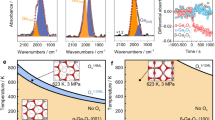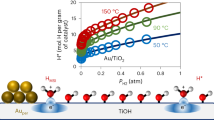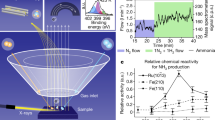Abstract
It has been established1–3 that oxygen chemisorbed at a metal surface can activate an otherwise unreactive molecule, as in the activation of S–H, N–H, O–H and C–H bonds. We have now extended these studies to more complex systems involving coadsorbed molecules in the hope of throwing some light on the mechanisms of heterogeneous catalysts. We have previously established the mechanisms by which unreactive molecular water, adsorbed on a Zn(0001) surface, is activated when co-adsorbed with nitric oxide4, and have demonstrated N–H activation in ammonia co-adsorbed with nitric oxide at an atomically clean Mg(0001) surface at 295 K (Fig. la and ref. 5). Activation was attributed to surface oxygen generated in the dissociative chemisorption of nitric oxide. Here we establish the nature of the ‘oxygen’ species involved and reveal details of the molecular steps.
This is a preview of subscription content, access via your institution
Access options
Subscribe to this journal
Receive 51 print issues and online access
$199.00 per year
only $3.90 per issue
Buy this article
- Purchase on Springer Link
- Instant access to full article PDF
Prices may be subject to local taxes which are calculated during checkout
Similar content being viewed by others
References
Au, C. T. & Roberts, M. W. Chem. phys. Lett. 74, 472–474 (1980).
Roberts, M. W. Adv. Catalysis 29, 51–95 (1980).
Roberts, M. W. Proc. Indian natn. Sci. Acad. 51A, 165–179 (1985).
Au, C. T. & Roberts, M. W. Proc. R. Soc. A396, 165–181 (1984).
Au, C. T., Carley, A. F. & Roberts, M. W. Phil. Trans. R. Soc. (in the press).
Tench, A. J. & Giles, D. JCS Faraday Trans. I 68, 193–196; 197–201 (1972).
Coluccia, S., Garrone, E. & Borello, E. JCS Faraday Trans. 1, 79, 607–613 (1983).
Au, C. T. & Roberts, M. W. (in preparation).
Au, C. T., Carley, A. F. & Roberts, M. W. Int. Rev. phys. Chem. (in the press).
Driscoll, D. J., Martir, W., Wang, Ji-Xiang & Lunsford, J. H. J. Am. chem. Soc. 107, 58–63 (1985).
Ito, T. & Lunsford, J. H. Nature 314, 721–722 (1985).
Thomas, J. M. Nature 314, 669–670 (1985).
Carley, A. F., Grubb, S. & Roberts, M. W. JCS chem. Commun. 459, 460 (1984).
Moroney, L., Roberts, M. W. & Smart, R. JCS Faraday Trans. I 79, 1769–1778 (1983).
Carley, A. F., Rassias, S. & Roberts, M. W. Surface Sci. 135, 35–51 (1983).
Author information
Authors and Affiliations
Rights and permissions
About this article
Cite this article
Au, C., Roberts, M. Specific role of transient O−(s) at Mg(0001) surfaces in activation of ammonia by dioxygen and nitrous oxide. Nature 319, 206–208 (1986). https://doi.org/10.1038/319206a0
Received:
Accepted:
Issue Date:
DOI: https://doi.org/10.1038/319206a0
This article is cited by
-
Methane Activation by Selective Oxidation
Topics in Catalysis (2016)
-
Low Energy Pathways and Precursor States in the Catalytic Oxidation of Water and Carbon Dioxide at Metal Surfaces and Comparisons with Ammonia Oxidation
Catalysis Letters (2014)
-
Heterogeneously Catalysed Oxidation Reactions with P450-like Characteristics; Radical Reactions and the ‘Elusive’ Oxygen State
Catalysis Letters (2011)
-
Scanning Tunnelling Microscopy: Surface Chemistry at the Atom-resolved Level, What’s New?
Topics in Catalysis (2005)
-
Evidence for the instability of surface oxygen at the Zn(0001)-O-Cu interface from core-level and X-ray induced Auger spectroscopies
Topics in Catalysis (1996)
Comments
By submitting a comment you agree to abide by our Terms and Community Guidelines. If you find something abusive or that does not comply with our terms or guidelines please flag it as inappropriate.



